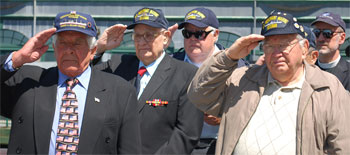After a “suicide run” across the Atlantic in a convoy that lost 17 ships, American John Ludwick and a fellow Merchant Marine were ready for a day in the city.
They left the tiny Soviet port city of Molotovsk for Arkhangelsk on New Year’s Eve 1944. Although the first leg of the trip went smoothly, the men ended up on the wrong train coming home and found themselves bound for Moscow, some 800 miles south.
After realizing their mistake, they boarded a new train that would bring them back to the White Sea, where their supply ship was frozen in. They never made it.
“We got hornswoggled into a labor camp,” Ludwick, 88, said in a recent phone interview. “We were forced labor; maybe not slaves, but forced labor.”
Russian soldiers, for reasons that aren’t clear to this day, ordered the Americans off the northbound train. Instead of rejoining their shipmates, they were taken by truck to war-torn Leningrad to clean the city and bury the dead.
Ludwick, who wrote a book about his experiences in the U.S. Merchant Marine, told these and other stories to John Thayer, an archivist at the Seamen’s Church Institute. Ludwick is one of 17 Merchant Marine veterans interviewed for the institute’s American Merchant Marine Veterans Oral History Project.
Seamen’s Church Institute, founded in 1834, is dedicated to assisting mariners worldwide. That mission, Thayer said, includes making sure Merchant Marine veterans’ stories don’t go untold.
“A lot of these folks are older,” he said. “It’s either do it now and get it on tape now or (these stories) are going to be lost forever. The Merchant Marine has not been completely forgotten, but it has been overlooked in its contribution to U.S. history.”
The Bay and Paul Foundations, of New York, awarded the Seamen’s Church a $5,000 grant earlier this year to support the project.
“We are going to use the money to expand the project to get more interviews from different places,” Thayer said. “I have been doing the work as part of my daily job. With this extra money we are going to be able to expand.”
Many existing interviews have been uploaded to the institute’s website. The stories are riveting.
In one segment, Merchant Marine veteran Richard Weir recalls traveling at the back of a convoy in an exposed position known as “coffin corner.” He and his shipmates had no idea another vessel in the convoy had sunk.
“I was on the watch of the bow at night at about 1 or 2 a.m. and all of a sudden I saw little lights off in the water around us,” said Weir, now a retired English professor. “Then I realized each of those lights represented one man who had turned on the little red light on his life jacket. These were seamen on this ship that had been sunk ahead of us.”
Weir, who was interviewed in January 2012, never learned the fate of those men.
Between 215,000 to 285,000 men served in the U.S. Merchant Marine during World War II, according to the website usmm.org. The men worked on ships that carried troops, armaments and other supplies for the war effort.
While Merchant Marine veterans still don’t qualify for full federal veteran benefits, they suffered the highest casualty rate of all the branches during World War II, according to the website.
Gabriel Frank, who served in the Merchant Marine from 1945 through 1968 and has worked for Seamen’s Church for many years, hopes the project will remind people about the role Merchant Mariners played in the war effort.
“A lot of seamen are passing on and a lot are getting up in age and (Thayer) is keeping us going with the memories of the Merchant Marine voyages,” said Frank, a retired probation officer interviewed in December 2011.
Ludwick, who now lives in Lyons, Kan., said his ship was harassed by submarines and air raids while crossing the Atlantic. He and his friend volunteered for double watch duty to spend New Year’s Eve in Arkhangelsk.
Although their luck soured on the train ride back to the ship, they caught a break when they arrived in Leningrad. The Russian officer in charge, who had spent time in the U.S., recognized them as Americans. He kept them separate from the other workers during four long weeks in Leningrad.
The officer and his wife ultimately helped the Americans escape. The plan was simple:
Ludwick and his friend would speed away on a snowmobile reserved for Russian dignitaries and find the railroad that would bring them back to their ship. The men learned to operate the machine from instructions translated from the Russian officer and his wife.
One clear night in late January 1945, the Americans went for it.
“They said it was 480 miles, but it was farther than that,” Ludwick said. “We got on it at night and we rode all night, all the next day and the next night without any sleep.”
They ultimately reached the tracks and later “bought (their) way back to the ship,” Ludwick said. They were missing for 30 days.About six months later, his time in the Merchant Marine was over. Two years at sea was enough.
“I came back to Kansas and said I’d never go to the ocean again.”

